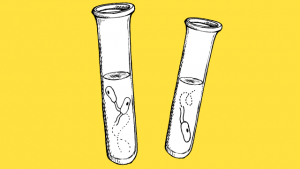Polluted water, damaged buildings and a dependency on fossil fuels are all big problems which are encountered by mankind daily. However, three unique solutions that use some of the smallest organisms on the planet showcase the remarkable power of microbial biotechnology.
Bacterial builders
Buildings are one step closer to being alive, thanks to a research team led by Dr Henk Jonkers at Delft University of Technology in the Netherlands. The team has created “bio-concrete”—a special mixture of concrete that contains dormant bacteria and their food source, which contains urea. When cracks appear in the concrete and water seeps in, the bacteria ‘wake up’ and metabolise the urea. Carbonate ions are formed as a waste product, which react with calcium ions already present in the concrete. The resulting calcium carbonate then fills in the cracks, allowing the buildings to effectively repair themselves.
This process is made possible by carefully selected bacteria. These bacteria live in soda lakes—among the only natural environments that have the same alkalinity as concrete. Moreover, the bacteria may remain dormant for up to 200 years, so the healing properties of the concrete will be present throughout a building’s lifetime.
Although bio-concrete is more expensive than traditional concrete, there will still be vast economic savings. Concrete is the most widely used construction material on earth and repairing it can be extremely costly, especially in hard to reach areas such as underwater tunnels.
From pollutants to protozoa
At Woods Hole Oceanographic Institute, Massachusetts, marine biologist Dr Scott Gallager has developed an ingenious method of detecting toxicants in drinking water by analysing how protozoa swim. Protozoa are organisms made up of just a single cell. This cell is covered in tiny hair-like protrusions, called cilia, which act like oars to enable the cell to move. Toxicants including pesticides and biological warfare agents affect the protozoa’s metabolism and cilia, which in turn alters their swimming.
To detect toxic components, rotozoa are placed in a sample of water, and observed using a digital camera and specially designed software. The protozoans’ swimming motion is compared to that in an uncontaminated sample. The apparatus is self-contained in a device called a Swimming Behavioural Spectrophotometer (SBS). From a single test, it’s possible to determine whether or not water is safe to drink.
The biologically based SBS can substantially save both time and money. Traditional chemical methods can take between 1 and 3 days to return results and cost up to $250. The SBS device provides almost instantaneous results for as little as $1 a test. Furthermore, the protozoans only need replacing every two months.
The project has received crucial commercial support from Petrel Biosensors who are helping to streamline the SBS so that it can be used as a handheld unit. United Nations statistics state there are currently 880 million people worldwide without access to clean water, meaning the impact of the device could be tremendous.
Algae power
The hunt for fuel usually begins with behemothic oil rigs tearing into the earth’s crust, but future fuels could come from humble microscopic algae. Companies such as Sapphire Energy in the USA, are preparing to scale up production of ‘Green Crude Oil’. They have managed to create strains of algae that produce oil molecularly similar to thin crude oil. This green oil can be immediately refined into alternatives to conventional petroleum-based transport fuels. Since the algae metabolise carbon dioxide from the atmosphere to produce the fuel in the first place, there are far less overall carbon dioxide emissions, but the advantages don’t stop there.
Ethanol is currently the bio-fuel of choice, but this is obtained by harvesting and fermenting maize, increasing the price of this food crop on the global market, making it unaffordable to those who need it most. Using algae instead allows the demand for fuel to be met without adversely affecting food security. The production plants would not even need to be on agricultural land—all that is needed is sunlight and carbon dioxide. The algae are grown in tanks that could be placed in relatively barren land, such as deserts.
Scaling up these technologies is looking increasingly promising. In September 2010, a crucial bill was passed in America that gives much needed financial incentives to algae-based renewable fuel. With this support, global adoption of algal biofuels is looking to be more and more hopeful.
Ian Polding is a 2nd year undergraduate in Biology at Somerville college..
Art by Samuel Pilgrim.
![Micromachines Polluted water, damaged buildings and a dependency on fossil fuels are all big problems which are encountered by mankind daily. However, three unique solutions that […]](/wp-content/uploads/2011/10/Micromachines_preview-620x300.png)
